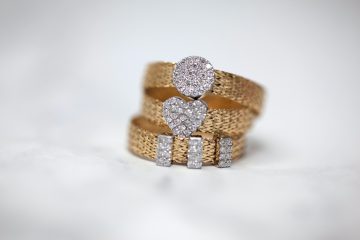Gold, since it began to be extracted, has had a special value to humans. As an expression of love, power, and wealth, it has always had a special place in our hearts.
Gold has been used for jewelry since prehistoric times. One of the first gold jewelry finds found originated in Bulgaria, all of 5000 years before Christ.
The world empire has always seen gold as a valuable source of wealth, and many wars have been triggered because of its status as a means of payment and signs of welfare. King Ferdinand of Spain, for example, ordered his men to obtain gold at all costs, which led to the indigenous kingdoms of South America being subjected to looting in the 15th century.
How much gold is there in the world?
By analyzing the current uptake rate, it has been concluded that all gold on the earth (above ground) corresponds to a weight of approximately 158,000 tonnes. If you were to take all this gold and fuse it, the amount would not be greater than a cube of about 20×20 meters. That would be about 2 small gold rings per person. Gold weighs 19.3 times as much as water, which means a liter of gold weighs a full 19.3 kilos.
How much remains underground is a difficult question to answer, new gold finds are constantly emerging and have throughout history led to many gold rushes, where people rushed to settle and risked gold for health and life. In the 19th century, this was a popular occupation for adventurous people. Today, most recycled gold is used in new jewelry, as the recovery of gold scrap is much more gentle on nature than mining.
Gold in jewelry
Gold is a great material to work with – it is relatively soft, beautiful, and resistant to rust, discoloration, and chemicals. In fact, gold is a so-called inert precious metal, which means that it is not affected at all by external factors. The gold excavated from the mines does not change in chemical form from the time it is taken up until it becomes a ring.
However, other metals are usually mixed in the gold, and can thus change properties such as color, hardness, and melting point. Copper is the most common metal to mix with. Around the world, gold usually looks a little different, from yellower to redder color changes. However, pure gold, 24 carat, always looks the same.
Gold shifts Gold shades of gold
By mixing different metals with the gold one can change its properties. For example, if you mix copper in the gold, it becomes reddish. If you mix silver and copper in equal quantities, you get the yellowish gold we are used to seeing. To obtain white gold, the gold is mixed with nickel or precious metal palladium. The white gold we are used to is therefore not a metal of its own but a mixture just like most of the gold in the trade.
Gold is one of the best conductors for electricity and has therefore been used for a long time in the industry. The fact that it is malleable and resistant to oxidation has made it a popular choice – among other things in dentistry and electronics. In fact, gold is so malleable that a single gram can be knocked out to an area of 1 square meter, giving it many uses. For example, many of the satellites in space are coated with a thin layer of gold, thanks to their resistance to electromagnetic radiation and radio waves.
Today, about 10% of all gold produced in the industry is used, with electronic appliances as the main area of use. In virtually every mobile phone, computer and car, there are elements of gold in electronics today.
Since gold is an inert metal, ie not affected by other chemicals or substances, gold has limited medical use. However, it has not prevented people from attributing gold medical properties for centuries – including in beauty care and health. Today, gold injections are used to reduce the swelling and pain of tuberculosis and osteoarthritis. Medical tests have shown that the effects of regular gold injections are diminished symptoms of joint inflammation and also a slowing of the course of the disease for osteoarthritis.
Tooth gold In dental care, gold has had a given place both to fill holes and replace teeth. Thanks to its agility and endurance, gold has been used in dental care since 700 years before Christ – then to fasten replacement teeth with thin gold threads. Gold has been used to fill holes for at least 1000 years. Gold leaves no traces in the body, which means that allergies and inconveniences from other metals can be avoided.
Recycling of gold
Gold that is recycled from, for example, jewelry and electronic devices is the most environmentally friendly gold. Within the Gold Alliance, we work exclusively with recycled gold as we create new jewelry. When we recycle your gold, it happens with regard to the environment. We send it to our partner in Germany where it is refined, ie separated from other metals and any coatings.



